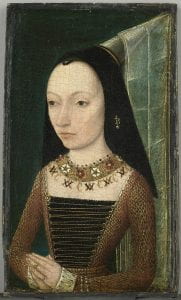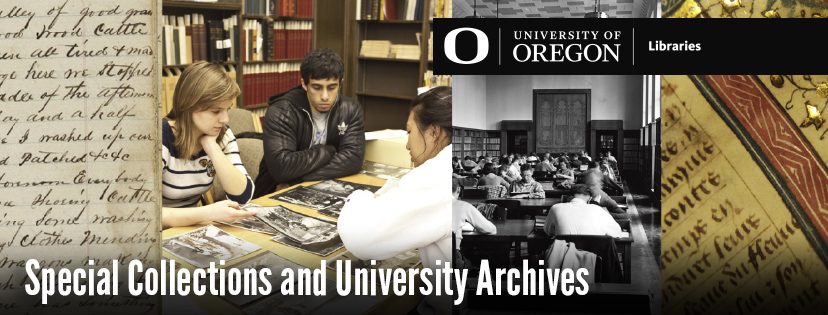First Book Printed in English by William Caxton
This year celebrates the 550th anniversary of the first book printed in the English language, Recuyell of the Historyes of Troye (1473-1474). This monumental achievement was accomplished by William Caxton, an English merchant living in Bruges. The story of the first printed book in English is one of international collaborations, personal networking, and the support of a renowned noblewoman, without whom the work would not have been completed.

We know much about Caxton due to in-depth research by modern scholars in the last four decades. The Wardens’ Account Books record that he apprenticed with Robert Large in 1438. Apprenticeships began at age fourteen, so we can be confident that Caxton was born in the first half of the 1420s. Large’s will of 1441 left Caxton twenty marks and it is likely this sum of money helped him make the voyage to Bruges to begin his life in business.
Caxton was a successful businessman, who was politically savvy and engaged with his fellow English merchants, serving as governor of Merchant Adventures. Most importantly, he built connections with royalty. In 1468, he was invited to attend the wedding of King Edward the IV’s sister, Margaret of York. Caxton had been involved behind the scenes in the marriage negotiations with the groom-to-be, Duke Charles the Bold. His status fell for a time when Edward went into exile. This downtime (1471-1472) provided him with an opportunity to travel and he made a fateful trip to Cologne, one of the earliest centers in the development of mechanical printing. His successor, Wynkyn de Worde, later confirmed that Caxton was bitten in Cologne by the printing bug.
Soon after his visit to Cologne, Caxton chose to translate The Recueil de Histories de Troye, written by Raoul Lefrevre for Philip the Good. The book focuses mainly on the exploits of Hercules, and it provided the dukes of Burgundy with a lineage with the heroes of Greece, through Hercules, it was claimed, who had married a Burgundian woman!
Printing was a new technology, and entrepreneurs who followed this career path often went bankrupt. Expertise in the process was needed. Paper and ink were very expensive. Like any business, printers had to cover their costs and make a living on whatever income was derived thereafter. Printing in English was a risk as most works at that time used Latin, not the vernacular of the place it was produced. English was quickly becoming an accepted language in both formal spoken venues, like Parliament (1362), and in written works like the English Bible (ca. 1380s). Thus, the shrewd businessman Caxton was strategic in choosing this work to translate into English.
In the preface of Recueil, Caxton explained that he found the translation to be more difficult than he expected. Caxton found help in the translation from none other than Margaret of York. Although there is no evidence that she provided financial support, she was a vital patron in both the translation and eventual distribution of the book. She was a bibliophile and her personal library included many religious and historical texts produced in the scribal tradition on vellum.

The use of Medieval English was also a challenge as it had a variety of regional dialects. People from northern England could barely understand those from the south. In a later work, Eneydos (his translation of Virgil’s Aeneid), Caxton admitted that “common English spoken in one shire varies from that of another” and that “the language we use today is very different from that which was spoken when I was born.” Thus, he decided on the London dialect, where wealth and literacy abounded, and which contained a mixture of Latin and French. His choice had an enormous, long-lasting influence because it set a standard for a broader community-shared spelling, grammar and syntax in spoken and written English.
It is not known how many copies of the Recuiel were printed. Sometime in 1473-1474, printing of the work was completed in Bruges. Only eighteen copies are known to survive today. He eventually moved his press to Westminster in 1476 near the gate to the Almonry (near the west end of the Abbey), where he printed his most famous work: Chaucer’s The Canterbury Tales. He died ca. 1491 and was buried in the churchyard of St. Margaret’s Westminster. His press was inherited by his partner, an equally remarkable printer and businessman, Wynkyn de Worde.
Few of Caxton’s works survive as a whole. More often leaves can be found in libraries. These sell at incredibly high cost (when available for sale) at more than $9,000/leaf. Special Collections (SCUA) is fortunate to have two original leaves from Caxton’s works:
Duff, E. Gordon (Edward Gordon). 1905. William Caxton. Chicago: The Caxton Club.
We also have William Morris’ Kelmscott Press editions of Caxton’s works that are considered some of the most beautifully crafted books ever made:
On April 30th, 1882, a stained-glass window was erected at St. Margaret’s where Caxton is buried. Following Caxton’s motto “Fiat Lux”, Lord Alfred Tennyson wrote:
Thy prayer was “Light, more Light” – while Time shall last!
Thou sawest a glory growing on the night,
But not the shadows which that light should cast,
Till shadows vanish in the Light of Light.
References
Blades, William. 1877. The Biography and Typography of William Caxton, England’s First Printer. London: Trubner & Co.
Crotch, W.J.B. 1928. The Prologues and Epilogues of William Caxton. London: Oxford University Press.
Deacon, Richard. 1976. A Biography of William Caxton: The First English Editor, Printer, Merchant and Translator. London: F. Muller.
Hellinga, Lotte. 2020. William Caxton and Early Printing in England. London: British Library.
Kuskin, William, ed. 2006. Caxton’s Trace: Studies in the History of English Printing. Notre Dame University Press.
Painter, George Duncan. 1977. William Caxton: A Biography. NY: Putnam.
Zeldenrust, Lydia. 2023. “Tales of Troy, Hercules, and a Printer called Caxton.” BBC History Magazine, 24:3, 26-31.
— David de Lorenzo, Giustina Director





